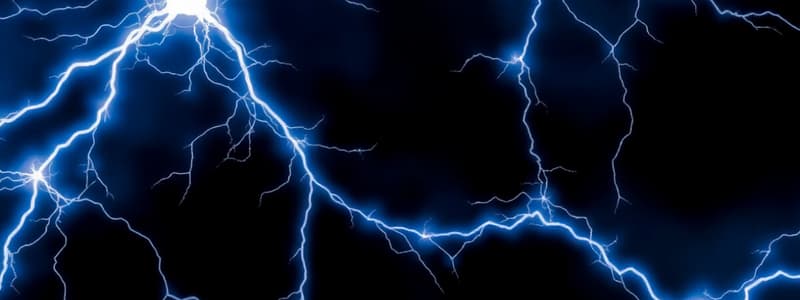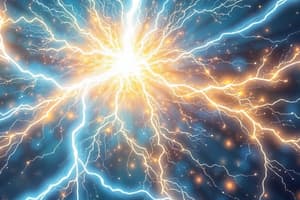Podcast
Questions and Answers
Which particle is negatively charged?
Which particle is negatively charged?
- Neutron
- Positron
- Proton
- Electron (correct)
An atom is electrically neutral if it contains unequal numbers of protons and electrons.
An atom is electrically neutral if it contains unequal numbers of protons and electrons.
False (B)
What is the charge on a single proton?
What is the charge on a single proton?
+1.6 x 10^-19 Coulomb
To have a total charge of -1 C, an object would need an excess of ______ electrons.
To have a total charge of -1 C, an object would need an excess of ______ electrons.
Match the following particles with their charges:
Match the following particles with their charges:
What is the charge of an electron?
What is the charge of an electron?
The unit of electric charge is known as the Joule.
The unit of electric charge is known as the Joule.
Explain how to determine if an atom is electrically charged.
Explain how to determine if an atom is electrically charged.
What is the relationship between objects with opposite charges?
What is the relationship between objects with opposite charges?
Insulators allow electrons to flow freely from atom to atom.
Insulators allow electrons to flow freely from atom to atom.
What is the unit of charge measured in?
What is the unit of charge measured in?
Conductors are materials that permit electrons to flow freely from particle to ____.
Conductors are materials that permit electrons to flow freely from particle to ____.
Which of the following describes a characteristic of static electricity?
Which of the following describes a characteristic of static electricity?
Static electricity involves the behavior of charged ____.
Static electricity involves the behavior of charged ____.
How does a physics teacher determine the charge on an object with an excess of protons?
How does a physics teacher determine the charge on an object with an excess of protons?
Match the materials with their properties:
Match the materials with their properties:
Flashcards
What are the fundamental particles of an atom?
What are the fundamental particles of an atom?
Electrons, protons, and neutrons are all particles that make up an atom. Electrons have a negative charge, protons have a positive charge, and neutrons have no charge.
How can you tell if an atom is electrically neutral or charged?
How can you tell if an atom is electrically neutral or charged?
An atom is considered electrically neutral when it has the same number of protons and electrons. If there is an imbalance, the atom becomes electrically charged.
What is the unit for measuring electric charge?
What is the unit for measuring electric charge?
The unit of charge is called the Coulomb (C). It represents the amount of charge an object possesses.
What is the charge of a single electron and proton?
What is the charge of a single electron and proton?
Signup and view all the flashcards
How is the total charge of an object related to its electrons and protons?
How is the total charge of an object related to its electrons and protons?
Signup and view all the flashcards
How many electrons are needed for a charge of 1 Coulomb?
How many electrons are needed for a charge of 1 Coulomb?
Signup and view all the flashcards
Conductors
Conductors
Signup and view all the flashcards
Insulators
Insulators
Signup and view all the flashcards
Electrostatic Force
Electrostatic Force
Signup and view all the flashcards
Static Electricity
Static Electricity
Signup and view all the flashcards
Elementary Charge
Elementary Charge
Signup and view all the flashcards
Electrostatic Charging
Electrostatic Charging
Signup and view all the flashcards
Electric Charge
Electric Charge
Signup and view all the flashcards
Proton
Proton
Signup and view all the flashcards
Study Notes
Introduction to Physics
- Topic: General Physics S2
- Instructor: Engr. Kazelle Anne A. Sallegue
- Welcome to new learning session.
- Expectations: Have paper, calculator (preferably scientific), and good listening skills.
Class Rules
- Be on time.
- Raise hand to ask questions or recite.
- Maintain respect in speaking and writing.
Learning Objectives
- Explain electron transfer in electrostatic charging.
- Solve problems involving electric charges, dipoles, forces, fields, and fluxes.
Electric Charge and Static Electricity
- Charge is a measurable quantity.
- Charge is measured in Coulombs (C).
- Charge on a single electron: -1.6 x 10-19 C
- Charge on a single proton: +1.6 x 10-19 C
Review of Subatomic Particles
- Electrons, protons, and neutrons are subatomic particles.
- Electrons are negatively charged, protons are positively charged, and neutrons are neutrally charged.
- Neutral atoms have equal numbers of protons and electrons.
Electrically Charged Atoms
- Imbalance in the number of protons and electrons creates a net charge.
Defining Electric Charge
- Charge reflects the imbalance between electrons and protons.
- To have a charge of -1 Coulomb, there will be 6.25 x 1018 excess electrons.
- To have a charge of +1 Coulomb, there will be 6.25 x 1018 missing electrons.
Static Electricity Concepts
- Opposites attract, and likes repel.
- Charged objects exert influence on each other.
- Two like charged objects repel each other.
Triboelectric Series
- A series of materials listed in order of their tendency to gain or lose electrons when rubbed against each other.
- Examples listed, and ranked by their electrostatic charge polarity.
Conductors
- Materials that allow electrons to flow freely.
- Charge distributes across the entire surface of a conductor.
Insulators
- Materials that impede the flow of electrons.
- Charge remains at the point of contact when transferred to an insulator.
Conductors vs. Insulators
- A comparison of materials and their conducting abilities.
- Examples listed ranging from Insulators to Conductors, with Semi-conductors in between.
- A visual example for using a conductor and an insulator.
Uniform Distribution of Charge on Conductors
- Explains that charges distribute evenly over a conducting surface.
- Use of diagrams to illustrate the conduct of metal vs an insulator when charged.
Summary of the Class
- Lesson 1 Recap: Electron vs. Proton, Neutron
- Lesson 2 Recap: Opposites attract, likes repel
- Lesson 3 Recap: Conductors and Insulators
- 1 electron = -1.6 x 10-19 Coulombs
Studying That Suits You
Use AI to generate personalized quizzes and flashcards to suit your learning preferences.




